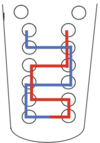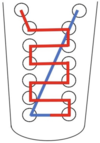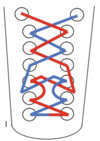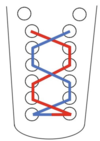How to tie your sport shoes?
Feet differ from one person to another, some have wide feet, others thin, others are stronger. And yet we don't tell you how to tie your shoes, whether you're wearing street shoes or sports shoes.
So find in this article some examples to teach you to tie your shoes, there are many others but here are the most common.
This advice is given by the podiatrists of the AIRPOD association:
Limit compression zones
Compression zones can affect several areas of the foot, which is why there are several types of lacing.
Compression can cause:
- Pain
- Rubbing
- Tingling
- Numbness
And the more the foot swells, the more the compression increases. It is therefore important to adapt the lacing of your shoe, especially when practicing a sport (running, hiking).
Here are 2 examples proposed by the podiatrists of the AIR POD association to reduce the points of compression of the shoe on the foot:


Fight against the heel that sticks out

The heel that stands out is important because the back of the foot rubs and moreover when you run in the mud you are more likely to lose your shoe.
The type of lacing proposed by the podiatrists of the AIRPOD association consists in making a mouth at the level of the 5th and 6th eyelets in order to block the kick and thus the back of the foot. Thus, your heel will rise less.
Of course, remember to take shoes that are adapted to your size.
Fight against the excessive advancement of the foot
The foot moves forward systematically when you walk, that's why there is a space between your toes and the tip of the shoe. Yes, that's why we put you upright at the shoe store and press between your big toe and the tip of the shoe. This space is usually 1 to 1.5 cm.
When you run, the movement of the foot is more important, that's why we advise you to take a size above in your running shoes or rollerblades.
But with a good shoe size if you still want to limit forward foot slide, here's a useful type of lacing.
To do this, you can make a mouth at the 2nd and 3rd eyelets.

Lacing for wide feet

A wide foot will rub on the shoe on the edges of the foot, so it is important to try to increase the volume of the shoe as much as possible.
Here are the pathologies and symptoms that can be found when the foot is wide and the shoe or lacing is not adapted:
- Extensor tenosynovitis
- Warm-ups
- Hyperkeratosis
- Phlyctene - blisters
- Pain
In this method of lacing, the goal is to limit the crossing of the laces but while allowing a good support of the foot. Here on this picture, an example of assembly proposed by the association of podiatrist AIRPOD.
There are also shoes with a wider or narrower toebox.
Marie Messager
Osteopath D.O
In Versailles (78)

